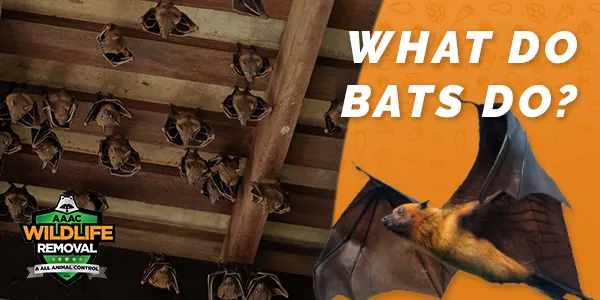Bats are some of the most fascinating creatures on earth. They live in a wide variety of habitats, eat an assortment of foods, and have evolved to be able to do things that other mammals cannot. Bats also play an important role in nature as pollinators and insect killers, but many people don’t know this! This article will explore what bats do in their day-to-day life and other fascinating things about them.

Are bats dangerous?
Bats are shy creatures and normally keep to themselves, the danger is in the diseases bats carry. They carry a significantly high number of viruses than any other mammal on earth. They are known carriers of rabies and other diseases such as the SARS virus, the MERS virus, Hendra virus, and even Ebola among other things. Bat bites are rare, however, it is important to not handle bats or to try to come anywhere near them. Additionally, the build-up of bat droppings in homes could also cause histoplasmosis, a severe respiratory infection with flu-like symptoms caused by breathing spores from bat guano. This is why it is vital to use professionals to clean bat poop in the attic, and other spaces near pets and family
Why are bats called bats?

The word “bat” was likely first used in the early 1570s and is derived from the Middle English word “bakke” – which most likely came from the old Swedish name for bats “natbakka” or “night-bat”. The shift from the letter k to t is very likely influenced by the Latin word “blatta” which means “light shunning insect”.
Amazing bat facts
Bats are really good at harboring diseases
Bats have long been known to be reservoirs of viruses that are deadly to humans – There are at least 60 viruses carried by bats that are zoonotic or can be passed on to people and most of these are severe or even life-threatening.
Bats don’t get sick with the viruses they host
Not only do bats carry diseases but they have evolved to act as carriers without getting sick themselves. Researchers believe that the key to this is flight. Flight elevates their metabolic rates causing their core body temperature to rise at 38C (100F) or more. This fever-like state, researchers have posited, would allow the bats’ immune system to keep pace with constant viral infection. Moreover, bats have also developed a mutation in their genes that helped control their immune response to infections in a way to avoid a cytokine storm – the excessive inflammatory response to infection that can be as harmful to the body as the infection itself.
Bats have a unique way of flying
Unlike birds, bats can move their wings independently from each other, this allows bats to fly with more agility than many other flying animals.
280 species are either endangered, near-threatened, or vulnerable
Of the over 1400 bats species in the world, more than 280 are either endangered, near-threatened, or vulnerable. Bats make up 20% of all mammals on earth and many are at risk for extinction with many others likely to join them soon. Urbanization and White-nose syndrome have played a major role in the decline of Bat populations.
Bats have unique mating habits
During bat mating season, bats will swarm in large groups and perform acrobatics – an act they do likely so the female can choose the most agile male partner. Once the female has chosen a male, the pair will go to a secluded area where they will mate. Learn more about how many babies bats have by clicking here.
Bats can eat their weight in insects in just one night
70% of species of bats are primarily insectivores, eating as much as their body weight in bugs every night. This helps in controlling insect populations and preventing the spread of insect borne disease.
Bats “see” with their ears
When hunting for food or navigating through dark spaces, bats use echolocation to assess where objects are. Bats produce sound waves with their mouths and the sound waves collide with objects all around them and bounce back to the bat’s ears, which allows bats to “see” what is around them. Bat echolocation can detect even very small prey from long distances away!
There are two types of bats: microbats and megabats
There are two categories of bats Megabats and microbats. The most common of the two are microbats like Mexican free-tailed bats and the bumblebee bat – these bats echo-locate using high-pitched sounds and feed on bugs like flies and moths. Megabats like flying foxes live in the tropics and rely more on their large eyes and a strong sense of smell to feed on pollen, nectar, and fruit.
They are quite diverse
Bats have over 1400 species and they can be found on every continent except Antarctica. They vary in size from Kitti’s hog-nosed bat which is as small as a bee to the giant golden-crowned flying fox which has a wingspan of over five feet!

Bats are mammals that give birth to live young
Unlike birds, bats produce milk like mammals do but they also have another trait unique to them – their babies cling onto their mother’s fur until they grow strong enough for flight. They even breastfeed while hanging upside down! Mother bats will not leave her baby unattended so sometimes she may take turns with other mothers who go out hunting at night while one stays back with their pups.
Mangoes, bananas, cacao, etc. would go extinct without bats
Bats are pollinators and seed dispersal agents and many of our favorite plants and fruit trees rely on bats for their reproduction. Without bats, we would be left with a world without mangoes, bananas, cocoa beans (used to make chocolate), etc. Bat guano is also an important soil fertilizer!
Their poop is called guano and it sparkles!
Bat poop is called guano and it is harvested around the world for use as fertilizer. Bat guano has been used in farming since ancient times and even until now bat poop continues to be popular amongst farmers. When crumbled you’ll notice that they glisten! this is due to the shiny material called chitin on insect exoskeletons. However, accumulation of guan in homes and buildings signals a clear need for bat remediation from companies like AAAC Wildlife Removal!
Bats can reach speeds of over 100 miles per hour!
Bats can fly really fast! Some, like Mexican free-tailed bats, can reach speeds of up to 100 miles an hour! Making them by far the fastest mammal on Earth!
Bats groom themselves like cats
Bats like to keep themselves clean, they spend a great deal of their time licking and grooming themselves. To some species, it is even a communal activity.
There are 3 bat species that suck blood
Of the 1400+ species of bats, only 3 are vampire bats that mainly feed on blood. There’s Desmodus rotundus, the common vampire bat, there’s the white-winged bat Diaemus youngi, and the hairy-legged vampire bat Diphylla ecaudata. They don’t really suck blood but cut V-shaped wounds and lick the blood off. Their saliva has anticoagulants that keep their meal bleeding so they can drink their fill.
They’re not blind, but most can see in low-light
Though bats are often thought of as creatures with poor eyesight because of their nighttime habits, this is actually false. Most bats have good vision especially for an animal who hunts at night when there isn’t much light around. Bats use echolocation more than rely on sight when hunting or navigating dark spaces – even though some species do still rely heavily on sight like megabat which hunts using smell rather than sound waves.
They’re the only flying mammals
Bats are the only real flying mammals (as flying squirrels only glide and do not really fly). Bat wings are actually hands that evolved skin membranes for the purpose of flight.
Bat populations are getting decimated because of white nose syndrome
Bats species that are not on the endangered list are still rapidly declining in population, and this is due to habitat loss and the white-nose syndrome. White-nose syndrome is a disease that causes bats to wake up during winter hibernation which forces them out of their caves and roosts causing them to starve to death.
Reason why you should love bats (outside your home)
- They feed on harmful insects such as mosquitoes and flies
- They eat crop destroying insects
- They pollinate plants
- They disperse seeds
- Their guano makes a great fertilizers
Bats play a very important role in our lives and the ecosystem, they disperse seeds from trees, pollinate our plants and protect us by eating insects that would otherwise be harmful or devour our crops! A large bat colony such as the one on Bracken cave can eat up to 220 tons of bugs in a night which amounts to millions of dollars saved annually from crop damage and health care! No matter where bats live, they have a positive impact on their environment. It is for this reason that bats are federally protected.
Conclusion
Bats are amazing animals that can help keep our environment healthy and sustainable. They’ve been around for a long time, but there is still so much we don’t know about them! Learning more about these fascinating animals is something everyone should do at least once.
FAQs
Are bats rodents?
Bats are often mistaken for rodents, but they are actually not related. Bat species make up more than 20% of the mammal population and outnumber both dogs and cats in terms of the number of different types found worldwide.
What do bats eat?
Most bat species are insectivores and feed on bugs such as moths, mosquitoes, beetles, etc., Some bats eat fruit, nectar, and pollen. There are also bat species that eat fish and bats in the vampire bat family who drink blood.
How do bats mate?
Bats reproduce by mating with other members of their own bat colony, some also disperse to other colonies at this time too. The female bat will give birth (pups) after a gestation period which is usually around seven to nine weeks.
Originally published on AAAC Wildlife Removal at https://aaacwildliferemoval.com/blog/bats/what-do-bats-do/





